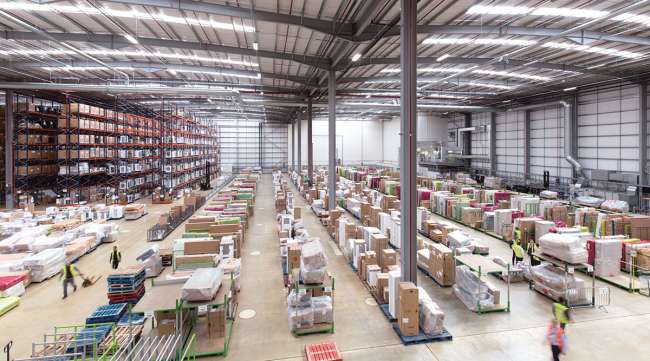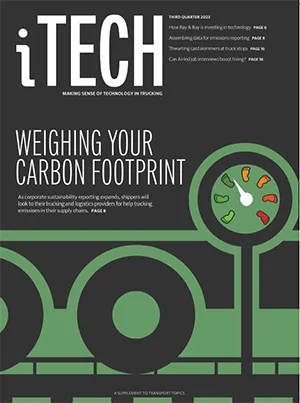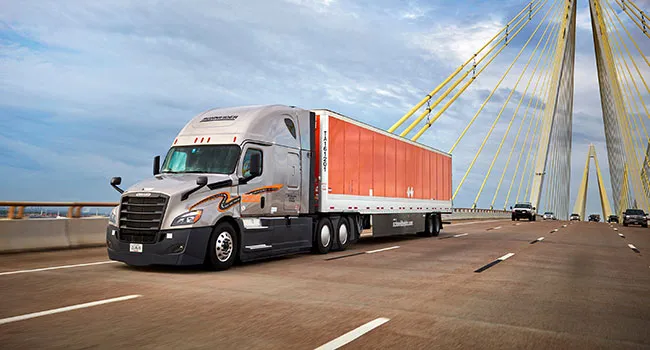Special to Transport Topics
The Trucking Industry Tackles Carbon Tracking

[Find the latest in trucking technology: Explore this quarter's issue of iTECH]
As corporate reporting on greenhouse gas emissions becomes increasingly commonplace and potentially regulated, more shippers will turn to their freight transportation providers for help tracking their carbon footprints.
Proposed rules by the U.S. Securities and Exchange Commission that would require publicly traded companies to collect, report and measure carbon emissions in their supply chains — and their progress toward reducing them — have motor carriers and third-party logistics providers thinking about the strategies, tools, processes and, most importantly, reliable data needed to meet this challenge.
The SEC proposal, aimed at enhancing and standardizing climate-related disclosures to investors, would further escalate public companies’ growing emphasis on ESG reporting — which stands for environmental, social and governance. Today, many businesses already are voluntarily disclosing how they are assessing, measuring and managing carbon emissions and related risks.
This ESG reporting will involve the participation of fleets and 3PL firms where their services contribute to greenhouse gas emissions in a shipper’s supply chain, said Bart De Muynck, executive vice president and chief industry officer for freight visibility software platform Project44.
“The shipper will need to be able to report carbon emissions generated by their own operations, as well as those generated by for-hire truckers who move their freight, and 3PLs who run warehouses on their behalf,” he said.
And while many fleets already collect operational data on fuel consumption, cargo weight and miles run, converting that information into reliable emissions reporting will not be a simple task.

Q3 iTECH
►Industry Tackles Carbon Tracking
►Fleets Test Carbon Capture System
►UT Unveils Fleet Sustainability Index
►Card Skimming at Truck Stops
►Q and A: Bay & Bay's Wade Anderson
►Dysart: Using AI for Job Interviews
►Clevenger: Roads to Decarbonization
Explore the Issue!
De Muynck recommended that shippers utilize a technology platform to collect, organize and analyze the data, including information from transportation management systems, warehouse management systems and other relevant third-party sources.
“[Fleets and shippers] will have to report to a common, auditable standard,” he added. “There will be a certain rigor around how you report. If I have 100 carriers in my routing guide, I need all of them to report to me in the same way with the same data sets.”
This type of reporting generally organizes greenhouse gas emissions into three categories.
Scope 1 emissions are those generated directly by assets that a company owns or controls. Emissions from a private trucking fleet, for example, are considered Scope 1 for that fleet operator.
Scope 2 refers to indirect emissions such as those created by the production of electricity and other energy purchased to run the business.
Scope 3 covers GHG emissions from upstream and downstream activities in a business’ value chain, including those generated by outside trucking, warehousing and logistics companies hired to provide transportation and distribution services.
De Muynck cited a Reuters report that found only 30% of U.S. organizations are currently reporting Scope 1 and 2 emissions, while less than 20% are reporting Scope 3.
“If you don’t know how much [emissions] you are putting out, how can you reduce it? You have to start reporting, then create benchmarks, then set plans and take actions,” he said.
Technology Vendors Rise to the Challenge
With telematics systems now installed in most commercial trucks, fleets increasingly have bushels of valuable data available on vehicle and driver performance, especially from electronic logging devices and engine control units. That data provides accurate insight into fuel consumption, miles driven and driver performance factors.
Yet collecting that data, in some cases from thousands of sources, and converting it into accurate emissions reporting can be a challenge.
Fleets operate different types of trucks with different engines, drivetrains and even fuel sources. A fleet mix could include trucks from a year to 10 years old, with some in linehaul service and others in local pickup and delivery, all of which have different emissions characteristics.
Then there is driver performance. Driver behaviors such as fast acceleration and hard braking can consume significantly more fuel — and create more emissions — than a driver who employs fuel-saving driving techniques.
Despite the complexity, some fleets already are starting to address this issue, and many technology suppliers are gearing up with tools and services as well as data collection and validation capabilities to support accurate reporting.

Ryan
“The best solutions for accurate tracking and reporting against ESG goals are ones that also help you reduce the environmental footprint of your operations with real-time data and analytics,” said Joe Ryan, vice president and general manager of telematics at Samsara.
The technology company recently introduced Samsara Sustainable Fleet Management, a feature that provides customers with data and insights on reducing emissions and maximizing fuel efficiency in support of their environmental sustainability goals.
Common data points to monitor and track carbon emissions across the supply chain can include fuel consumption, idling time, miles per gallon, temperature and humidity tracking, along with driver behavior, Ryan said.
“All of this data can be collected from commercial vehicles, trailers or other equipment using [Internet of Things] sensors, and then processed and delivered in the cloud to deliver actionable insights,” he said.
One example Ryan cited was Samsara customer Summit Materials. He said the Samsara platform helped close data gaps and more accurately record emissions, which enabled the construction materials company to set meaningful reduction targets.
“That saved $1.8 million in fuel costs,” he said. “Streamlining fuel management is a key part of Summit’s ongoing ESG initiative,” which, Ryan added, aims to achieve a 75% reduction in emissions across its business.
“A unified view of ESG data gives organizations the data and intelligence to establish actions to reduce emissions, as well as drive operational efficiencies,” Ryan said. “All of which can have meaningful impact on ESG progress — and address a principal tenet of the new regulations.”
Saleh ElHattab, founder and CEO of software firm Gravity Climate, said shippers can look to some existing tools for help measuring and reporting GHG emissions.

ElHattab
“Tools that already track vendor data, fuel consumption, distance traveled or shipment type may offer preliminary measurements, or at least organize and export relevant data in a useful way,” he explained.
Yet shippers likely will need additional support and tech tools to properly organize, attribute, report and audit data, particularly from upstream and downstream partners. That’s where purpose-built carbon accounting tools come in.
Gravity Climate’s software platform specializes in emissions measurement and reduction recommendations for complex supply chains and transportation and logistics, he said.
Depending on a company’s operations, other reportable emission sources beyond freight transportation could include building heating and electricity and employee commuting, tracked over the course of a year and reported annually, ElHattab said.
“In the world of emissions measurement and management, demonstrating progress is key,” he emphasized. “The first step is to set a baseline. Then, you can compare absolute emissions year-over-year” and measure emissions in financial ways, such as emissions per dollar of revenue.
“Customers want to understand the [return on investment] … from monitoring emissions,” ElHattab said. “We find [they are] often pleasantly surprised how quickly they see ROI from increased competitiveness, customer relationships, compliance costs and operational efficiencies.”

Platform Science counts among its customers major truckload carriers such as Schneider National. (Schneider)
Another software vendor expanding into the emissions reporting space is telematics provider Platform Science.
For fleets, and to a lesser extent 3PLs, one of the biggest barriers to accurate and complete GHG reporting is “a reliable foundation of data sources that is consistent across [a] mixed fleet of vehicles and operational uses,” said Darrin Demchuk, Platform Science’s vice president of strategy and corporate development.
Platform Science counts among its customers major truckload carriers such as Schneider and Werner Enterprises, as well as Walmart and other private fleet operators.
Platform Science also partners with manufacturers such as Daimler, Navistar and Paccar to integrate its software in trucks at the factory level, which makes it easier to deploy software upgrades, he said.
Demchuk said interoperability — having an open platform that can accept, absorb and accurately assemble and present data from many sources — is key for GHG reporting.
He cited three imperatives for successful data acquisition, management and monitoring to meet GHG reporting needs. First, gather a reliable foundation of data sources that is consistent across a mixed fleet of vehicles. Second, define key data attributes produced by the vehicle, driver, carrier and shipper so that they can be filtered into the format needed to meet requirements. Third, measure everything the company is doing, constantly.
“That could include how you dispatch, load trucks, set up routes, coach drivers on behavior, reduce idling, fuel use and other waste,” Demchuk said. “As a fleet, you must have confidence in the [data] foundation but leave room for trial-and-error experimentation to improve. If your fleet technology decision limits you to exactly one path to a solution, you better hope it is the right path.”
Eric Mallia, vice president of sustainability solutions for Geotab, said fleet customers today use Geotab’s Green Fleet Dashboard to identify and aggregate their total fuel consumption and GHG emissions.
“The approach we are taking is reading true fuel consumption from the engine control unit,” he said. The company applies its Curve Logic software tools to collect high-frequency data without high transmission costs.
“Generally, what [shippers] want is aggregated [data] at a trip level, across a vehicle, fleet or time parameter,” Mallia said.
Geotab can then import, through application programming interfaces or other connections, additional source data to round out the completeness of reporting.
Applying the appropriate emissions factor is critical, Mallia said. Then identifying “the opportunity for reduction and how you are going to progress toward that reduction goal is really critical for the fleet and the shipper,” he added.
Trimble Transportation, which earlier this year acquired cloud-based transportation management platform Transporeon, offers multiple solutions for capturing, vetting and reporting GHG emissions. Serge Schamschula, head of ecosystem at Transporeon, said the company’s latest product, Carbon Visibility, leverages several of Trimble’s strengths and data already on the platform, including integrations with more than 600 telematics providers and a network of supply chain stakeholders.

“The biggest challenge to tracking and reporting emissions isn’t in technology, but in human behavior,” Schamschula explained. “The trucking industry doesn’t currently have a strong data-sharing culture, and transparency is often seen as a threat rather than an opportunity. This is an area of necessary improvement for the industry.”
Tracking and reporting emissions is still a new frontier for many shippers and carriers.
“My experience is that most shippers, carriers and 3PLs are just starting to become familiar with supply chain emissions, and many likely have not yet set ESG goals,” Schamschula said. “Their questions are usually around the basics, including where they should start.”
He emphasized that carriers and shippers “should understand that calculating, tracking and reporting emissions data and [key performance indicators] is a joint venture.”
“The more primary data that can be shared throughout the supply chain, the better,” he added.
A Competitive Advantage
The 3PL community is taking similar steps to collect GHG data from their managed operations on behalf of shippers and provide data reporting and measurement for warehouse-related emissions.

Fitzsimmons
Meagan Fitzsimmons, chief compliance and ESG officer at GXO, said the contract logistics company has set targets to reduce Scope 1 and 2 emissions 30% by 2030 compared with 2019 levels. GXO tracks facility energy usage as well as fuel for material handling equipment. The company is in the process of rolling out LED lighting across the majority of its facilities to help reduce energy consumption.
Fitzsimmons cited the company’s GXO Direct service as a flexible option for shippers to help reduce their Scope 3 environmental impact. In this shared warehousing model, customers use only a portion of the facility along with other brands. She said this reduces overall utility usage assigned to each customer since clients share various utility resources.
“Energy usage can be sub-metered or otherwise allocated to make sure each customer receives their associated footprint,” Fitzsimmons added.
GXO, based in Greenwich, Conn., ranks No. 6 on the Transport Topics Top 100 list of the largest logistics providers in North America.

For trucking and logistics providers, efforts to improve operational efficiency typically reduce carbon emissions as well. (Ryder System)
“Environmental performance goes hand in hand with a lot of operational efficiencies,” said Margarita Kruyff, environmental services director at truck leasing and logistics provider Ryder System.
She said Ryder focuses on meeting each customer’s specific reporting needs by leveraging its in-house expertise.
“Emissions reporting is a very rapidly evolving area,” she said. “Expertise is critical. Without it, a tool is just a tool. The customer has to define what is applicable or not … we [then] lean on globally recognized standards to help us think through how to meet reporting needs and define what data, tools and metrics [the customer] should be considering.”
Ryder’s Supply Chain Solutions business unit ranks No. 10 on the TT Top 100 list of logistics providers and No. 9 on the TT Top 100 list of North America’s largest for-hire carriers.
Ultimately, as more fleets and logistics providers adopt standardized GHG and sustainability reporting, shippers will start using such data in requests for proposal.
Project44’s De Muynck said fleets’ emissions profiles could then become a significant factor in the carrier selection process.
“Now I can make decisions also considering carrier impact on my supply chain GHG emissions,” he said. “That then becomes a much more strategic carrier selection process that can have dramatic effect on sustainability score.”
Want more news? Listen to today's daily briefing below or go here for more info:




